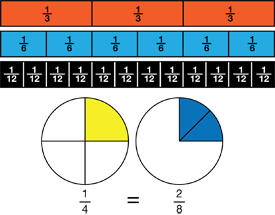Students fold uniform strips of paper into equal parts to show halves, fourths, and eighths, labeling each part according to the fraction it represents. Students use their completed strips to show specific fractions, to compare fractions, and to find equivalent fractions. In the next lesson, students expand their study as they use fraction strips to explore thirds, fourths, fifths, sixths, eighths, ninths, tenths, and twelfths.
Content in this Lesson
- Representing fractions using fraction strips and number lines [E1] and [E2].
- Defining numerator and denominator.
- Identifying fractional parts of a whole.
- Comparing fractions using fraction strips [E9].
- Comparing fractions using common numerators [E9].
- Finding equivalent fractions using fraction strips [E8].
- Naming and representing fractions greater than one as mixed numbers or improper fractions using models [E5].
- Writing number sentences from models of fractions [E6].
Assessment in this Lesson
| Assessment | Expectation Assessed |
|---|---|
|
Examples from class discussion in Part 1 |
|
|
Fraction Strips Homework section |
|
|
DPP Item A |
|



















